Smartwatches have already reached a sales scale of over 10 billion and continue to grow year after year. It can be said that it has become the most favored smart wearable device today. Although smartwatches have a significant market presence, I believe that as a high-tech smart product, they are still not as mature in technology and experience as smartphones. Especially in core functions like health and fitness, there can be significant differences even between major brands.
Friends often ask me which smartwatch has comprehensive health features? Which smartwatch provides accurate measurements? With these questions in mind, we decided to purchase and test all the mainstream high-end smartwatches available on the market to see which brand excels in functionality and performance, and which price range is more suitable for different consumers.
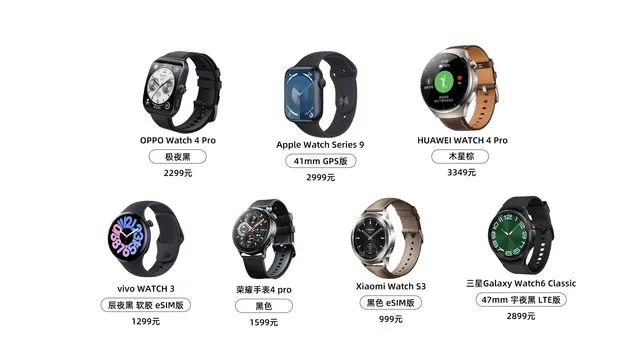 We purchased a total of seven mainstream smartwatches, including: HUAWEI WATCH 4 Pro, Apple Watch Series 9, Samsung Galaxy Watch 6 Classic, OPPO Watch 4 Pro, Xiaomi Watch S3, vivo WATCH 3, and Honor Watch 4 Pro.
We purchased a total of seven mainstream smartwatches, including: HUAWEI WATCH 4 Pro, Apple Watch Series 9, Samsung Galaxy Watch 6 Classic, OPPO Watch 4 Pro, Xiaomi Watch S3, vivo WATCH 3, and Honor Watch 4 Pro.
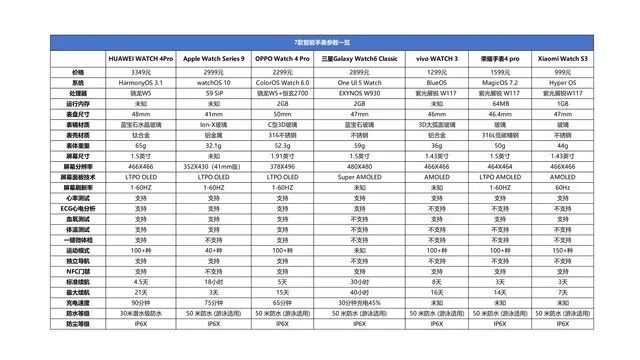 We will compare various dimensions including appearance, wearing experience, screen performance, health features, fitness functions, battery life, charging speed, positioning, calling, and system experience. The main objectives are to check the accuracy of core health and fitness testing functions across different price ranges and to help consumers find the best cost-effective models in their budget.
We will compare various dimensions including appearance, wearing experience, screen performance, health features, fitness functions, battery life, charging speed, positioning, calling, and system experience. The main objectives are to check the accuracy of core health and fitness testing functions across different price ranges and to help consumers find the best cost-effective models in their budget.
Appearance and Wearing Experience:
Regarding the pure appearance of the products, I think everyone has their own ideas and aesthetics, so we will only display them without judgment. I believe that the quality of most watches is quite good.
Our main focus is on two points: first, the wearing experience based on the weight of the watch including the strap; second, the experience of finger operation.
Firstly, regarding weight and wearing experience, the top three lightest watches including the strap are vivo, Xiaomi, and Apple, while the heaviest three are Samsung, OPPO, and Honor. Theoretically, the lighter the overall weight, the better the wearing experience.
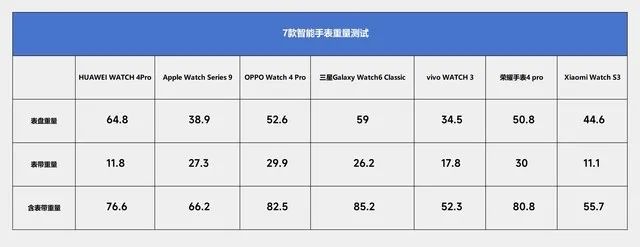 It is worth mentioning that among the seven watches, the heaviest Samsung watch has the most noticeable weight on the wrist. We have some doubts about this because the second heaviest OPPO is only less than 3g lighter than Samsung, while the pure watch body weight of Huawei is the heaviest. However, the weight feeling of Samsung is the most pronounced.
It is worth mentioning that among the seven watches, the heaviest Samsung watch has the most noticeable weight on the wrist. We have some doubts about this because the second heaviest OPPO is only less than 3g lighter than Samsung, while the pure watch body weight of Huawei is the heaviest. However, the weight feeling of Samsung is the most pronounced.
We speculate that this may be due to the internal weight distribution of the watch body, and the larger dials of Huawei and OPPO disperse the weight better. Additionally, we replaced Samsung’s strap with a lightweight nylon strap provided randomly, and the weight reduced to 68.8g, significantly improving the wearing experience. Therefore, if you are sensitive to weight, you can refer to this order when selecting straps: nylon > leather > silicone > metal.
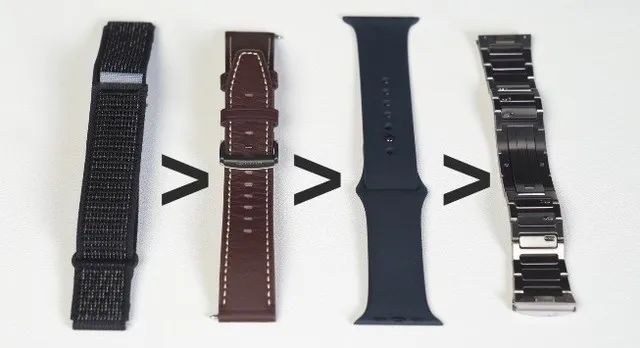 Next, regarding the touch sensitivity of the screen, overall, the seven smartwatches perform quite well, with a smooth and silky touch.
Next, regarding the touch sensitivity of the screen, overall, the seven smartwatches perform quite well, with a smooth and silky touch.
However, it is worth noting that different watches have different screen and bezel embedding processes. For instance, Apple and VIVO use a 3D convex screen design, while Huawei, OPPO, and Honor adopt a flat screen design, so fingers do not feel the boundary during touch. Xiaomi, due to its interchangeable dial design, has a dial that is slightly higher than the screen, which means fingers will touch the noticeable metal bezel during operation, and Samsung, due to its rotating bezel design, has a dial that is significantly higher than the screen, which constrains the operation space and results in a slightly poorer user experience.
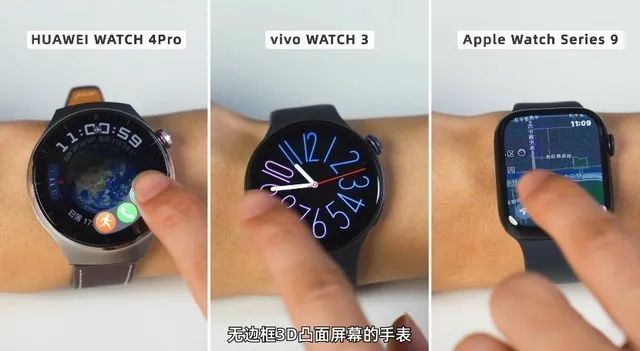 In summary, lighter watches are more suitable for long-term wear, especially during sleep. In terms of touch experience, products with a borderless 3D convex screen design perform better than flat and framed designs.
In summary, lighter watches are more suitable for long-term wear, especially during sleep. In terms of touch experience, products with a borderless 3D convex screen design perform better than flat and framed designs.
However, it is worth mentioning that the performance of smartwatches is largely linked to their weight, meaning that heavier watches often have stronger performance. While this is not absolute, the overall trend is such that if you care more about functionality and performance, you will indeed need to sacrifice some pursuit of lightweight design.
Screen Brightness Test:
There are also significant differences in brightness among different smartwatches. In indoor environments, such brightness performance is sufficient, but can products with lower brightness still be visible in strong outdoor light?
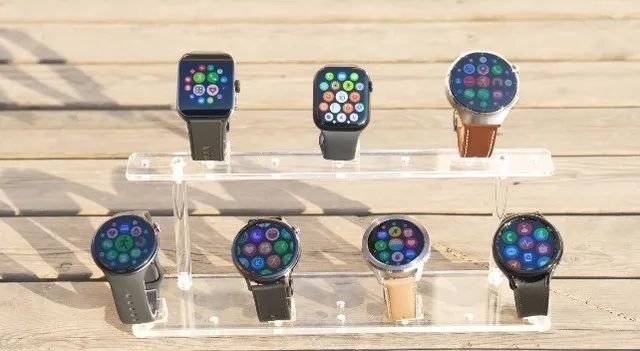 From our testing of the maximum screen brightness of the watches in outdoor environments, OPPO and Apple performed better, but other brands can also ensure visibility outdoors. Additionally, we also used a light meter for testing, and the data table is provided below for reference.
From our testing of the maximum screen brightness of the watches in outdoor environments, OPPO and Apple performed better, but other brands can also ensure visibility outdoors. Additionally, we also used a light meter for testing, and the data table is provided below for reference.
 Overall, if you frequently use your watch in outdoor environments, you must pay attention to the screen brightness parameter when choosing a watch, and try to select products with brightness above 1000 nits for better display clarity.
Overall, if you frequently use your watch in outdoor environments, you must pay attention to the screen brightness parameter when choosing a watch, and try to select products with brightness above 1000 nits for better display clarity.
Health Function Test (Heart Rate, Blood Oxygen):
Recently, news reported a case where a man relied on the health monitoring functions of a smartwatch to detect heart-related diseases early, allowing for timely treatment. This shows that by 2023, the health functions of smartwatches have already acquired considerable practical value and reference significance. Since the health functions vary among different watches, we focused on testing the most basic and commonly used blood oxygen and heart rate measurements.
To better determine the accuracy of the test results, we prepared medical-grade blood oxygen and heart rate monitors as comparison data points. Furthermore, to ensure the reference value of the data, we divided the tests into two groups based on gender and tested the static heart rate and blood oxygen data.
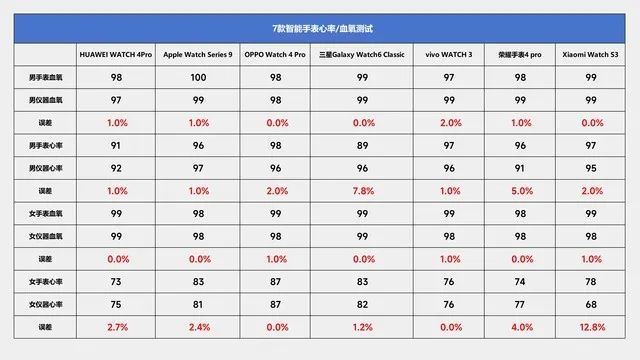 From the tests, we can see that currently, the vast majority of smartwatches have achieved very high accuracy in heart rate and blood oxygen testing. The products with extremely high accuracy are OPPO, Huawei, Apple, and VIVO. The results of our single tests will inevitably contain errors, but continuous multiple tests during daily wear can reflect the body’s true situation more accurately. However, it is worth noting that Samsung’s blood oxygen testing method requires a specific body posture, making it relatively inconvenient.
From the tests, we can see that currently, the vast majority of smartwatches have achieved very high accuracy in heart rate and blood oxygen testing. The products with extremely high accuracy are OPPO, Huawei, Apple, and VIVO. The results of our single tests will inevitably contain errors, but continuous multiple tests during daily wear can reflect the body’s true situation more accurately. However, it is worth noting that Samsung’s blood oxygen testing method requires a specific body posture, making it relatively inconvenient.
Fitness Function Test:
In terms of exercise types, there is almost no significant difference among major brands, with official promotions supporting dozens to over 150 exercise modes. However, more than 90% of these exercise modes are niche. Through practical testing, I found that these exercise modes only provide basic testing functions such as heart rate monitoring and calorie consumption, which are not very meaningful for niche groups engaged in those sports. Therefore, when purchasing a watch, do not be misled by the number of exercise modes.
In fact, the sports we commonly use generally cover running, cycling, and swimming. Therefore, for users, it is sufficient to focus on whether the watch accurately tracks their most frequently used sports.
I have also organized the default sports items for each watch. Overall, each brand defaults to common sports such as running, walking, cycling, and swimming, but there is some confusion with Xiaomi’s watch, which supports swimming but has not included professional skiing as a default mode, requiring users to add it independently, which is quite perplexing.
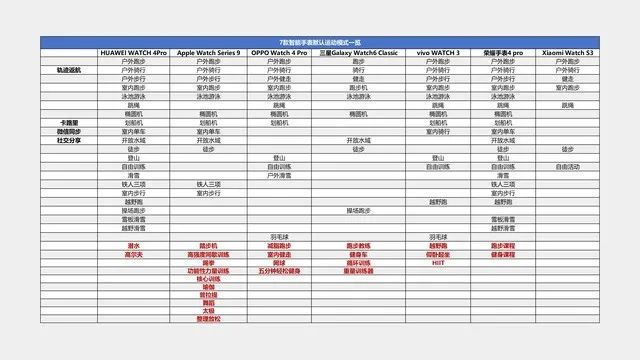 Moreover, from the table, we can also see the focus differences among brands. For example, Huawei’s watch is positioned as a high-end flagship, so it additionally supports sports modes such as diving and golf, while OPPO and VIVO have included badminton in their default sports. Additionally, according to official materials, badminton and professional running are key features promoted by OPPO.
Moreover, from the table, we can also see the focus differences among brands. For example, Huawei’s watch is positioned as a high-end flagship, so it additionally supports sports modes such as diving and golf, while OPPO and VIVO have included badminton in their default sports. Additionally, according to official materials, badminton and professional running are key features promoted by OPPO.
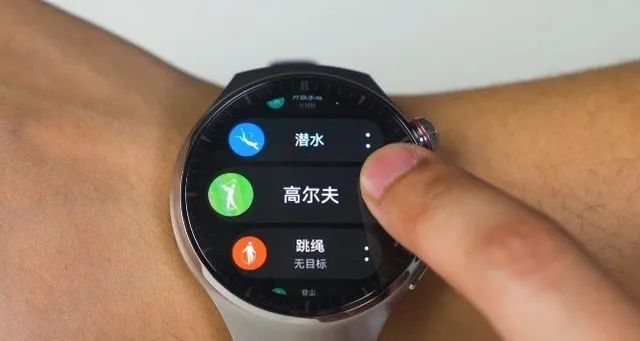 Brands like Samsung, Honor, and OPPO have also included related courses and instructional features in their default sports, which is quite user-friendly for those with relevant exercise needs.
Brands like Samsung, Honor, and OPPO have also included related courses and instructional features in their default sports, which is quite user-friendly for those with relevant exercise needs.
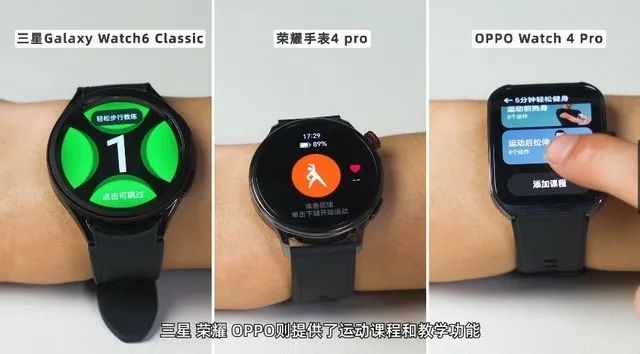 Next, we will test the experience of outdoor cycling, running, and walking.
Next, we will test the experience of outdoor cycling, running, and walking.
In the cycling test, from the commonly used data, the vast majority of smartwatches show little difference in core metrics such as speed, heart rate, and calorie consumption. In terms of data richness, aside from Samsung’s watch displaying fewer functional parameters, the other six products do not show significant differences.
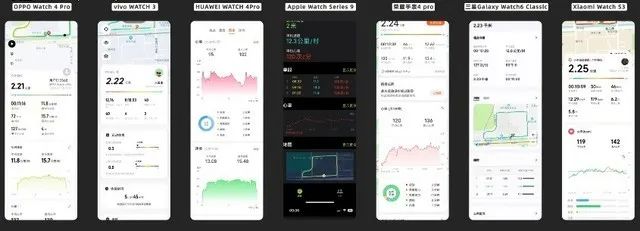 In the running test results, Apple and OPPO excel in supporting professional parameters, providing more guidance for professional runners. Samsung also supports advanced running metrics but does not display specific data. The remaining four watches have fairly similar data metrics.
In the running test results, Apple and OPPO excel in supporting professional parameters, providing more guidance for professional runners. Samsung also supports advanced running metrics but does not display specific data. The remaining four watches have fairly similar data metrics.
In the hiking test results, the functional differences among brands are not significant either. If you prefer more data testing, consider some domestic brands.
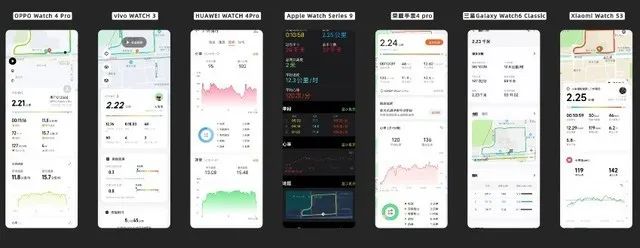 Overall, for those who have additional requirements for diving, golf, and other sports, Huawei’s watch is better. If you are a running enthusiast, you may consider Apple and OPPO.
Overall, for those who have additional requirements for diving, golf, and other sports, Huawei’s watch is better. If you are a running enthusiast, you may consider Apple and OPPO.
Positioning Accuracy Test:
The fitness functions of smartwatches rely on positioning. Our original plan was to directly assess the positioning capabilities of different watches through latitude and longitude data, but we found that only Huawei and Samsung support viewing latitude and longitude, while most watches do not. Therefore, we changed the test project to directly assess positioning capabilities through the cycling activity track data. This time, we tested a distance of 2.3KM.
 From the test results, the watch that was closest to 2.3KM was Huawei, followed by Apple and Xiaomi. From the summary route maps of each watch, they all recorded our travel trajectory quite completely.
From the test results, the watch that was closest to 2.3KM was Huawei, followed by Apple and Xiaomi. From the summary route maps of each watch, they all recorded our travel trajectory quite completely.
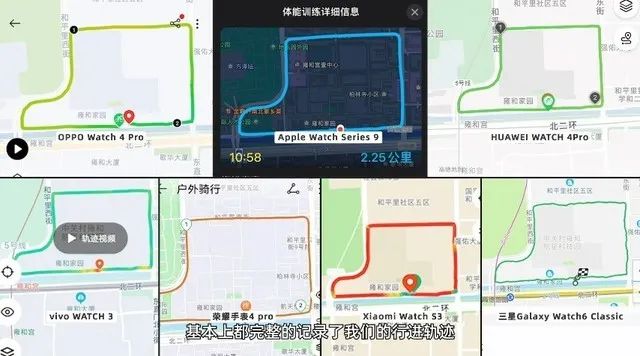 However, upon zooming in on the details, almost every watch showed positioning that was not 100% on the road. In terms of starting point accuracy, Huawei and Apple had relatively high accuracy, while Samsung and Honor showed positioning in the river.
However, upon zooming in on the details, almost every watch showed positioning that was not 100% on the road. In terms of starting point accuracy, Huawei and Apple had relatively high accuracy, while Samsung and Honor showed positioning in the river.
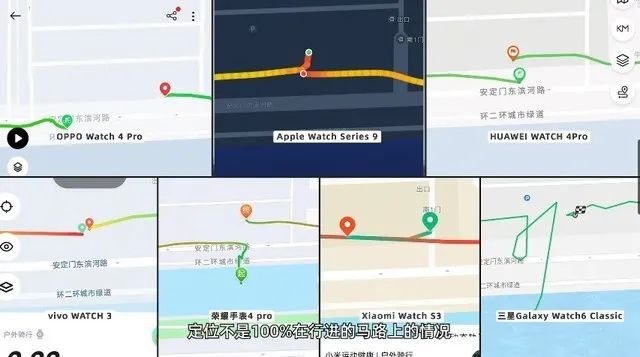 Call Stability and Clarity Test:
Call Stability and Clarity Test:
For smartwatches, whether as an extension of mobile communication or as an independent esim, the strength of call capability is very important. We also tested the call performance of the seven smartwatches while connected to a mobile phone, observing the signal and speaker conditions.
In terms of call signal, only Xiaomi experienced multiple instances where the watch did not respond after a call was made. In terms of call volume, OPPO and Samsung had louder sound, while Apple, Huawei, and VIVO had normal sound, and Honor and Xiaomi had quieter sound. In terms of clarity, the call quality of the seven watches was quite good, and the call content could be heard clearly.
Battery Life and Charging Test:
As flagship smartwatches, how do their battery performance and charging speeds compare? Is there a situation where they need to be charged twice a day or take several hours to fully charge?
First, we conducted a 6-hour static test, and the results are as follows: from the results in the table, the standby power consumption of these seven watches is very low.
Next, we conducted a 13-hour full-function wearing test, during which we enabled the highest frequency health monitoring according to the software settings of different watches. From the test results, the watches with the highest power consumption were Apple at 70% and Samsung at 75%. If worn in full-function mode, these watches generally require charging every 1-1.5 days.
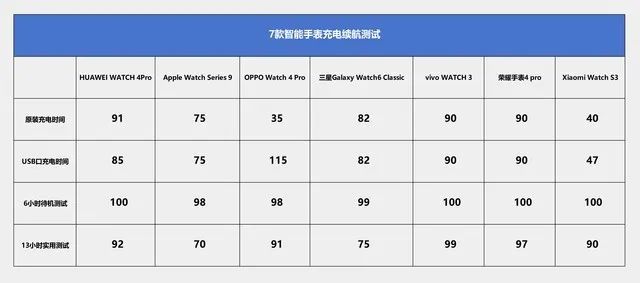 Next, we conducted charging tests. Except for Apple and Samsung, we used a 5V2A USB interface for charging the other watches. From the test results, the Xiaomi watch charged from 0-100% in just 47 minutes, while OPPO took the longest at 115 minutes. Most watches were charged within an hour and a half.
Next, we conducted charging tests. Except for Apple and Samsung, we used a 5V2A USB interface for charging the other watches. From the test results, the Xiaomi watch charged from 0-100% in just 47 minutes, while OPPO took the longest at 115 minutes. Most watches were charged within an hour and a half.
It is worth mentioning that we later used the 100W charger from OPPO’s phone to charge the OPPO watch, significantly improving the charging speed to 35 minutes. Therefore, if you want faster charging speeds, it is recommended to use the original chargers from each brand.
Regarding charging speed, I believe that for a secondary necessity product like a smartwatch, a charging speed of under two hours does not significantly affect user experience.
In terms of battery life, since smartwatches involve all-day health monitoring, the triggering logic and frequency vary among different brands, resulting in noticeable differences in battery life. This means that we cannot simply judge the battery life of a smartwatch using a unified power consumption standard like we do with smartphones. Generally, battery life is closely related to the comprehensive performance of the watch, where stronger performance can lead to higher power consumption and weaker battery life.
Software Richness and System Experience Test:
For mobile operations, we feel that they are quite similar, but for smartwatches, I believe the differences are much larger. Next, we will discuss the comprehensive system experience of smartwatches from four aspects.
In terms of basic applications, the differences among watches are generally proportional to their prices, with the main differences reflected in the following aspects: first, only Huawei, Apple, OPPO, and Samsung (which requires synchronization with a Samsung phone) support independent Wi-Fi functions.
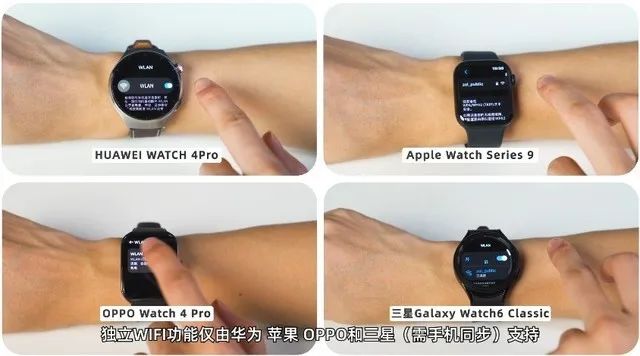 Additionally, apart from Huawei, Apple, and OPPO supporting independent maps, the other watches do not support independent map navigation, and Apple’s compatibility with NFC access cards is generally poor.
Additionally, apart from Huawei, Apple, and OPPO supporting independent maps, the other watches do not support independent map navigation, and Apple’s compatibility with NFC access cards is generally poor.
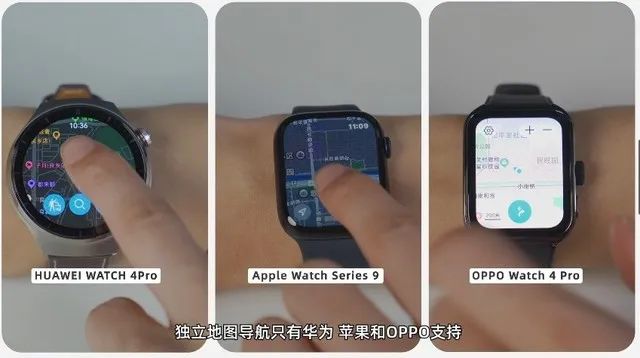 Moreover, the Xiaomi watch tested this time is relatively low-end in terms of price and positioning and does not support WeChat message reading. This flaw may significantly impact most users.
Moreover, the Xiaomi watch tested this time is relatively low-end in terms of price and positioning and does not support WeChat message reading. This flaw may significantly impact most users.
In terms of health functions, I have made a simple statistic, with heart rate, blood oxygen, sleep, and stress monitoring (Apple Watch requires third-party software support) being standard features for most watches.
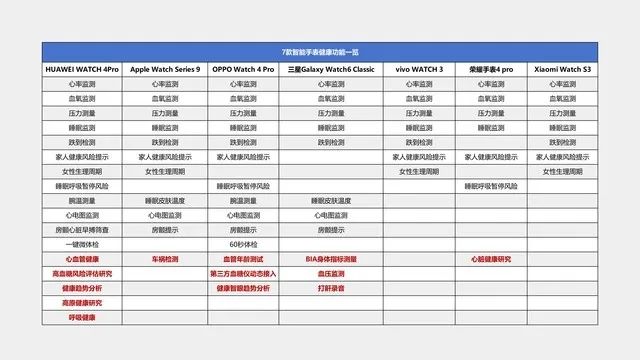 High-end features such as wrist temperature, ECG, and atrial fibrillation monitoring are only supported by flagship models from Huawei, OPPO, Apple, and Samsung, with Apple and Samsung’s wrist temperature tests only supported during sleep.
High-end features such as wrist temperature, ECG, and atrial fibrillation monitoring are only supported by flagship models from Huawei, OPPO, Apple, and Samsung, with Apple and Samsung’s wrist temperature tests only supported during sleep.
Additionally, Huawei and OPPO have extended their health functions further, such as supporting one-click micro-checks that can test multiple body indicators at once.
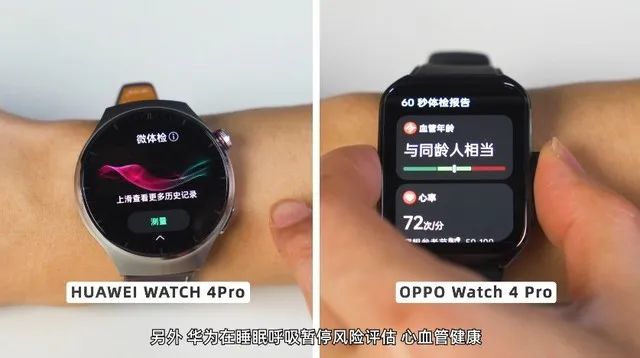 Furthermore, Huawei has made more functional extensions in key health areas such as sleep apnea risk assessment, cardiovascular health, high blood sugar risk assessment, and respiratory health. OPPO has also added support for sleep apnea risk research, vascular age, and third-party dynamic blood glucose meter integration.
Furthermore, Huawei has made more functional extensions in key health areas such as sleep apnea risk assessment, cardiovascular health, high blood sugar risk assessment, and respiratory health. OPPO has also added support for sleep apnea risk research, vascular age, and third-party dynamic blood glucose meter integration.
Samsung has introduced unique features such as blood pressure monitoring and BIA body index measurement, which can measure data such as skeletal muscle and body fat, similar to a body fat scale. However, Samsung’s blood pressure monitoring is not the way we traditionally understand it; it requires additional blood pressure meters for reference and algorithm calibration to achieve.
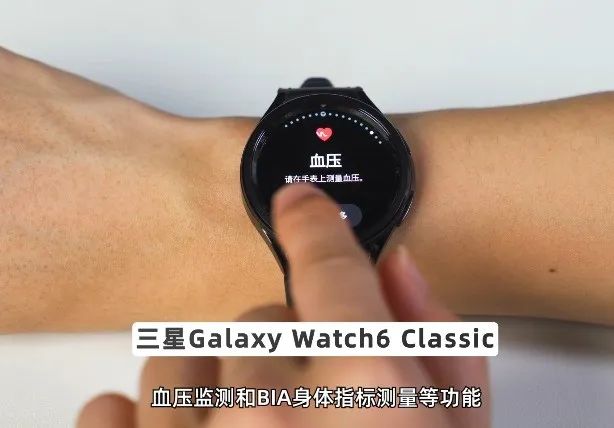 In summary, Huawei has the most comprehensive core health functions, followed by OPPO. Both domestic brands are at the forefront of research in the smart wearable health field.
In summary, Huawei has the most comprehensive core health functions, followed by OPPO. Both domestic brands are at the forefront of research in the smart wearable health field.
In terms of UI usability, the operational logic of several domestic smartwatches is quite similar to that of the smartphones we commonly use, with swiping up or down for control center and notification bar, left or right for weather, sports, health, payment, etc. A short press of the crown will bring up the watch app interface, and rotating it allows for scrolling up and down or zooming in and out. The lower button is mostly set to invoke the sports function, while Huawei supports three lower button function settings. Overall, the operational logic of domestic smartwatches aligns well with our smartphone usage logic, resulting in a low learning curve.
Samsung’s operational logic is slightly different, with swiping down for the control center, swiping up for the application interface, and the unique rotating bezel operation allowing for switching between sports, health, weather, payment, and other core functions, which also provides a good experience. However, it is worth mentioning that Samsung’s application interface is the only one that only supports icon display, which is not very user-friendly, while other watches allow for adjusting application arrangement or enlarging applications to view application names, making them more user-friendly.
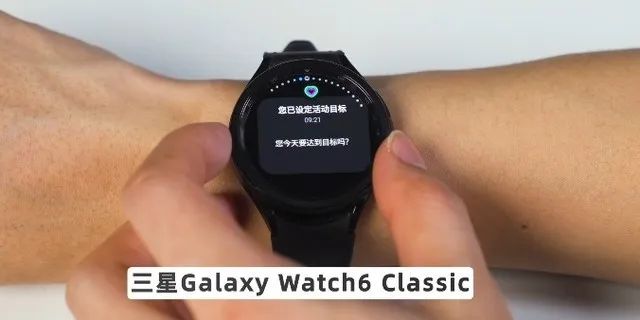 The default swiping down on the Apple Watch brings up notifications, swiping up brings up sports, schedules, weather, etc., and continuing to swipe up switches to the application interface, while a short press of the lower button brings up the control center. Overall, the operational logic of the Samsung and Apple watches differs slightly from that of mainstream domestic watches and our accustomed operational concepts, requiring some adaptation and learning.
The default swiping down on the Apple Watch brings up notifications, swiping up brings up sports, schedules, weather, etc., and continuing to swipe up switches to the application interface, while a short press of the lower button brings up the control center. Overall, the operational logic of the Samsung and Apple watches differs slightly from that of mainstream domestic watches and our accustomed operational concepts, requiring some adaptation and learning.
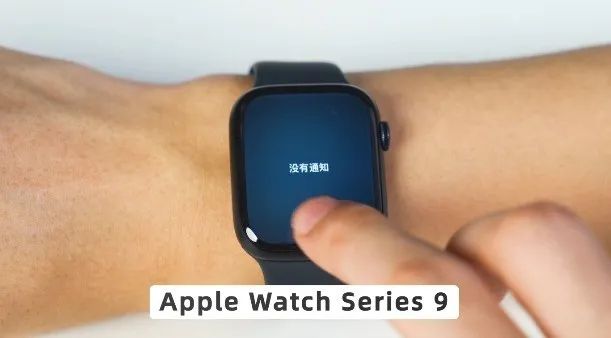 It is worth mentioning that both the Apple and OPPO watches support gesture control, allowing for operations on the watch without direct touch, which is particularly useful in situations where both hands are occupied, such as answering calls or replying to WeChat messages with one hand.
It is worth mentioning that both the Apple and OPPO watches support gesture control, allowing for operations on the watch without direct touch, which is particularly useful in situations where both hands are occupied, such as answering calls or replying to WeChat messages with one hand.
In terms of software expansion, all watches except Honor and Xiaomi support downloading third-party apps from the app store. However, it is worth noting that while VIVO’s watch supports third-party application expansion, it requires downloading on the phone and the supported applications are limited.
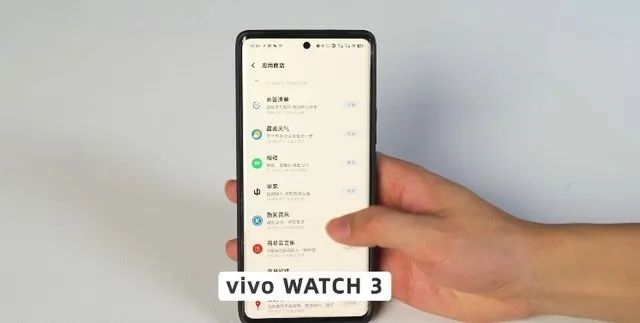 Overall, regarding software expansion, Apple, with its powerful ecosystem and large number of developers, naturally has the strongest expansion capability. Whether for daily life or entertainment, its playability is very high.
Overall, regarding software expansion, Apple, with its powerful ecosystem and large number of developers, naturally has the strongest expansion capability. Whether for daily life or entertainment, its playability is very high.
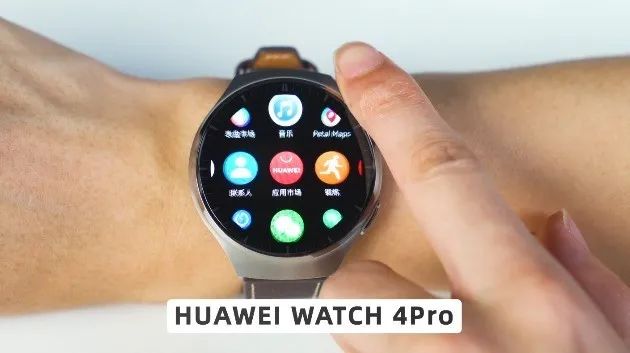 Meanwhile, Huawei, OPPO, and Samsung’s flagship watches have similar application types, covering basic applications for daily life and entertainment. In terms of quantity, Huawei has relatively more applications.
Meanwhile, Huawei, OPPO, and Samsung’s flagship watches have similar application types, covering basic applications for daily life and entertainment. In terms of quantity, Huawei has relatively more applications.
Summary and Product Recommendations:
The testing video for the seven smartwatches is indeed a bit long, and the testing process is far more complex than we imagined. Since our goal is more about comparing basic or homogeneous functions rather than providing a real long-term wearing experience, the results, items, and even the study of personalized functions of a specific watch cannot be very detailed, and I hope everyone can understand this.
Through this evaluation, my most profound feeling is that the smartwatch industry is one where you get what you pay for. Unlike smartphones, where there is not much difference in basic functions between a 1000 yuan and a 5000 yuan phone, a smartwatch can have significant functional differences when the price varies by a few hundred yuan.
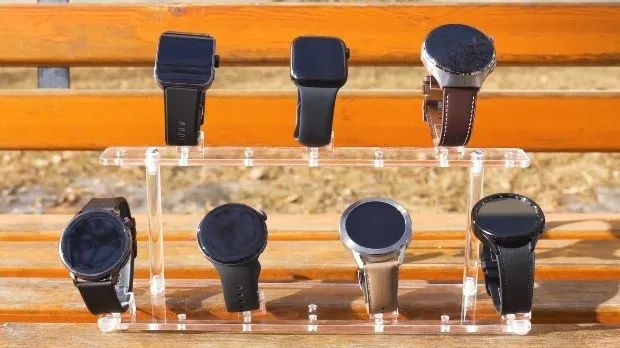 This means that the barriers to upgrading smartwatch functions are much greater than those for smartphones. Therefore, the key to choosing a smartwatch is still to align it with your budget.
This means that the barriers to upgrading smartwatch functions are much greater than those for smartphones. Therefore, the key to choosing a smartwatch is still to align it with your budget.
So how should one choose a smartwatch in 2023? I will summarize briefly: first, the Samsung Galaxy Watch 6 Classic is not recommended for non-Samsung phone users. The first reason is that the watch’s functions are severely tied to Samsung phones, and non-Samsung phones cannot use features like blood pressure and BIA. Secondly, compared to its price, its performance in terms of functionality, ecosystem, and usability is not outstanding, and there are many alternatives at the same price point.
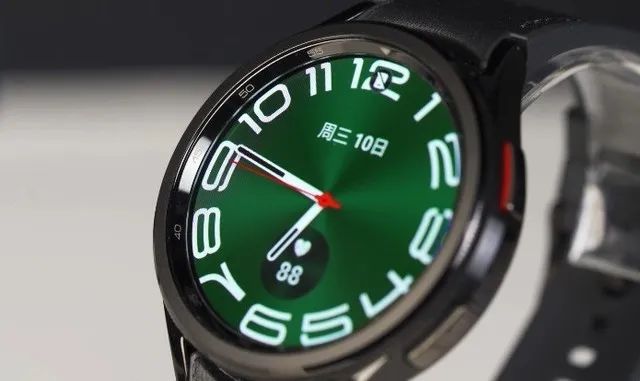 Next is the Apple Watch Series 9, which is basically a must-have option for Apple phone users. Aside from its ecosystem ties, the Apple Watch itself is indeed very powerful, with good practicality and playability. However, the support for NFC access cards and the need to charge daily are significant drawbacks, and its health function richness is weaker than that of domestic flagship models.
Next is the Apple Watch Series 9, which is basically a must-have option for Apple phone users. Aside from its ecosystem ties, the Apple Watch itself is indeed very powerful, with good practicality and playability. However, the support for NFC access cards and the need to charge daily are significant drawbacks, and its health function richness is weaker than that of domestic flagship models.
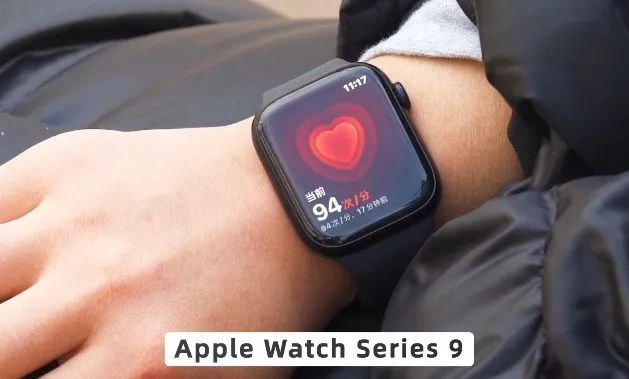 Next are the HUAWEI WATCH 4 Pro and OPPO Watch 4 Pro, which represent true flagship domestic smartwatches. Overall, their experiences resemble that of a small smartphone, and they are very comprehensive in functionality, especially in health functions, truly making them excellent wearable devices for personal health protection.
Next are the HUAWEI WATCH 4 Pro and OPPO Watch 4 Pro, which represent true flagship domestic smartwatches. Overall, their experiences resemble that of a small smartphone, and they are very comprehensive in functionality, especially in health functions, truly making them excellent wearable devices for personal health protection.
 However, if you do not have such extreme demands for health functions and are more focused on basic health and fitness data recording, NFC payment, message notifications, etc., I think you can lower your budget and consider products like VIVO WATCH 3, Honor Watch 4 Pro, and Xiaomi Watch S3. You could even consider lighter and cheaper band products, which offer better wearing experiences.
However, if you do not have such extreme demands for health functions and are more focused on basic health and fitness data recording, NFC payment, message notifications, etc., I think you can lower your budget and consider products like VIVO WATCH 3, Honor Watch 4 Pro, and Xiaomi Watch S3. You could even consider lighter and cheaper band products, which offer better wearing experiences.
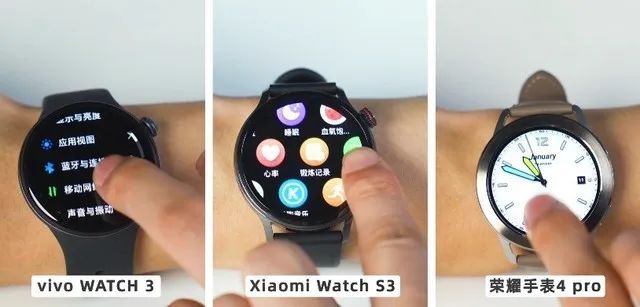 In summary, returning to the beginning, whether it is a smartwatch or a band, the number of functions generally correlates with the price. Identifying your needs and budget is the key to selecting the most suitable product for yourself.
In summary, returning to the beginning, whether it is a smartwatch or a band, the number of functions generally correlates with the price. Identifying your needs and budget is the key to selecting the most suitable product for yourself.
